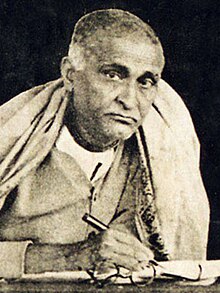| গৌড়ীয় মঠ | |
 Sri Gaudiya Math, Bagbazar, Kolkata Sri Gaudiya Math, Bagbazar, Kolkata | |
| Successor | Gaudiya Mission and Sri Chaitanya Math |
|---|---|
| Established | 6 September 1920 (104 years ago) (1920-09-06) |
| Founder | Bhaktisiddhanta Sarasvati |
| Founded at | Calcutta, British India |
| Dissolved | 1937; 88 years ago (1937) |
| Type | Religious organization |
| Purpose | Educational, Philanthropic, Religious studies, Spirituality |
| Headquarters | Calcutta, British India |
| Location |
|
| Region served | British India British Burma London, UK Berlin, Germany |
| Official languages | Bengali, English |
| Affiliations | Gaudiya Vaishnavism |

The Gaudiya Math (/mʌt/, /mɑːt/; Gauḍīya Maṭha) is a Gaudiya Vaishnava matha (monastic organisation) formed on 6 September 1920, about 30 months after Bhaktisiddhanta Sarasvati took sannyasa, the renounced order of life. On 7 March 1918, the same day he took sannyasa, he established the Sri Chaitanya Math in Mayapura in West Bengal, later recognised as the parent body of all the Gaudiya Math branches. Its purpose was to spread Gaudiya Vaishnavism, the philosophy of the medieval Vaisnava saint Chaitanya Mahaprabhu, through preaching and publishing.
From the beginning of Chaitanya's bhakti movement in Bengal, devotees, including Haridasa Thakur and others, whether Muslim or Hindu by birth, have been participants. This openness and disregard for the traditional caste received a boost from the "broad-minded vision" of Bhaktivinoda Thakura, a nineteenth-century magistrate and prolific writer on bhakti topics, and was institutionalised by his son and successor Bhaktisiddhanta Sarasvati Thakura in the twentieth-century Gaudiya Math.
Branches

The Gaudiya Math had established 64 branches. Most were in India, but preaching centres were maintained for a time in British Burma, England and Germany. The first European preaching center was established in London in 1933 (London Glouster House, Cornwall Garden, W7 South Kensington) under the name Gaudiya Mission Society of London'. Lord Zetland, the English Secretary of State, was the president of this society. The second European preaching center was opened by Swami B.H. Bon Maharaj in Berlin (W30 Eisenacherstr. 29).
History
Soon after the Srila Bhaktisiddhanta Saraswati's death (1 January 1937), a dispute began and the original Gaudiya Math mission divided by the court in 1948 into two administrative bodies which continued preaching on their own, up to the present day. In a settlement they divided the 64 Gaudiya Math centers into two groups. Sri Chaitanya Math Branch were headed by Srila Bhakti Vilasa Tirtha Maharaj. Gaudiya Mission were headed by Ananta Vasudev Prabhu, who became known as Srila Bhakti Prasad Puri Maharaj after accepting sannyasa for short duration.
Many of the disciples of Bhaktisiddhanta Sarasvati did not agree with the spirit of these newly created two fractions, or were simply inspired to expand the mission of their guru on their own enthusiasm, started their own missions. Many of these autonomous missions are still known as Gaudiya Math. Some of the other notable new missions are:
- Sri Gaudiya Vedanta Samiti established by Bhakti Prajnan Keshava Maharaj and Bhakti Rakshak Sridhar Goswami Maharaj (1940)
- Sri Chaitanya Saraswat Math established by Bhakti Rakshak Sridhar Maharaj (1941)
- Sri Chaitanya Gaudiya Math [bn] established by Srila Bhakti Dayita Madhav Goswami Maharaj (1953)
- International Society for Krishna Consciousness established by A. C. Bhaktivedanta Swami Prabhupada (1966)
- Sri Krishna Chaitanya Mission [bn] established by Srila Bhakti Vaibhava Puri Goswami Maharaj (1966)
- Science of Identity Foundation established by Siddhaswarupananda Paramahamsa (1977)
- Sri Sri Radha Govindaji Trust established by Srila Bhakti Hridaya Bon (1979)
- Sri Caitanya Sangha, a.k.a. Gaudiya Vaishnavite Society, established by Tripurari Swami (1985)
- Sri Gopinatha Gaudiya Math [bn] established by Srila Bhakti Pramode Puri Goswami Maharaj (1989)
Some are very large missions, and some are smaller branches started by individual Vaishnavas. What they hold in common is that they are autonomous branches of the tree of the Gaudiya Math. Almost all of them have published books and periodicals and opened one or more temples. There is little cooperation among these missions. Nevertheless, in 1994 many of them formed united the World Vaisnava Association — Visva Vaisnava Raj Sabha (WVA–VVRS).
References and notes
- ^ Sherbow, Paul H. (2004). "A.C. Bhaktivedanta Swami's Preaching in the Context of Gaudiya Vashnavism". In Bryant, Edwin F.; Ekstrand, Maria L. (eds.). The Hare Krishna Movement: The Postcharismatic Fate of a Religious Transplant. New York: Columbia University Press. pp. 129–46. ISBN 0-231-12256-X. Archived from the original on 22 April 2023. Retrieved 10 February 2022. p. 130.
- ^ Devamayī dāsi, "A Divine Life: Śrīla Bhaktisiddhānta Saraswatī Ṭhākura Prabhupāda" in Prabhupada Saraswati Thakur: The Life & Precepts of Śrīla Bhaktisiddhānta Saraswatī, Mandala Publishing, Eugene, Oregon: 1997, pp. 24, 26, 49. ISBN 978-0-945475-10-1.
- ^ Sherbow 2004, p. 139.
- ^ Jones, Constance A.; Ryan, James D. (2007). "Gaudiya Math". Encyclopedia of Hinduism. Encyclopedia of World Religions. J. Gordon Melton, Series Editor. New York: Facts On File. p. 165. ISBN 978-0-8160-5458-9. Archived from the original on 20 October 2022. Retrieved 10 February 2022.
{{cite encyclopedia}}: CS1 maint: bot: original URL status unknown (link) - ^ Swami B. A. Paramadvaiti (1999). Our Family — the Gaudiya Math. A study of the expansion of Gaudiya Vaisnavism and the many branches developing around the Gaudiya Math. VRINDA The Vrindavan Institute for Vaisnava Culture and Studies. ISBN 3-927745-90-1. Archived from the original on 13 April 2019. Retrieved 20 December 2018.
- Sherbow 2004, p. 131.
- Gaudiya Mission official website
- Brzezinski, Jan (2004). "Charismatic Renewal and Institutionalization in the History of Gaudiya Vashnavism and the Gaudiya Math". In Bryant, Edwin F.; Ekstrand, Maria L. (eds.). The Hare Krishna Movement: The Postcharismatic Fate of a Religious Transplant. New York: Columbia University Press. pp. 73–96. ISBN 0-231-12256-X. Archived from the original on 22 April 2023. Retrieved 10 February 2022. p. 89.
- Sri Gaudiya Vedanta Samiti official website
- Sri Chaitanya Saraswat Math official website
- Sri Chaitanya Gaudiya Math official website
- International Society for Krishna Consciousness official website
- Sri Krishna Chaitanya Mission official website
- Science of Identity Foundation official website
- Gaudiya Vaishnavite Society (Sri Caitanya Sangha) official website
- Sri Gopinatha Gaudiya Math official website
- ^ Brzezinski 2004, p. 90.
- Jones & Ryan 2007, pp. 504–505.
| Nadia district topics | |||||||||
|---|---|---|---|---|---|---|---|---|---|
| General | |||||||||
| History | |||||||||
| Religion | |||||||||
| Subdivisions | |||||||||
| Municipalities | |||||||||
| Community development blocks |
| ||||||||
| Rivers | |||||||||
| Transport | |||||||||
| Railway stations | |||||||||
| Institutes of higher learning | |||||||||
| Lok Sabha constituencies | |||||||||
| Vidhan Sabha constituencies | |||||||||
| Former Vidhan Sabha constituencies | |||||||||
| Former Lok Sabha constituencies | |||||||||
| See also | |||||||||
| New religious movements | |
|---|---|
| Major groups |
|
| Notable figures |
|
| By region | |
| Concepts |
|
| Public education | |
| Scholarship | |
| Opposition | |
| Lists | |

